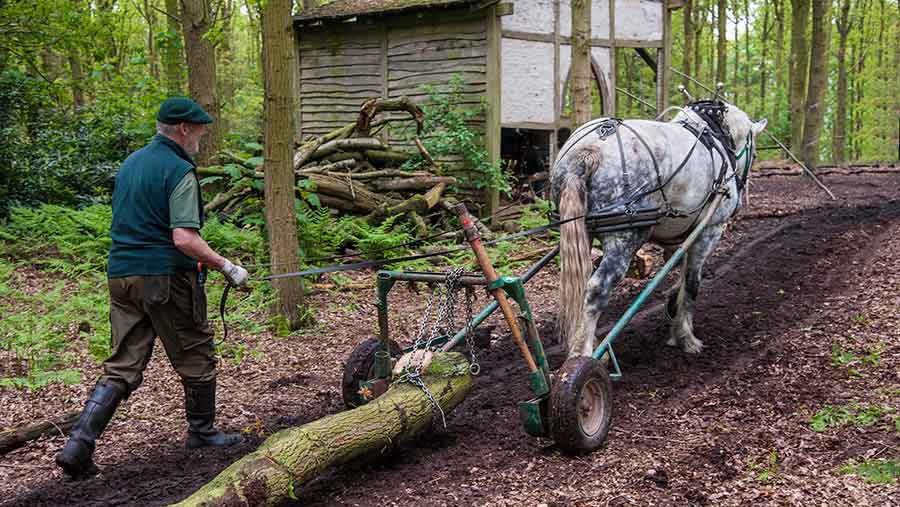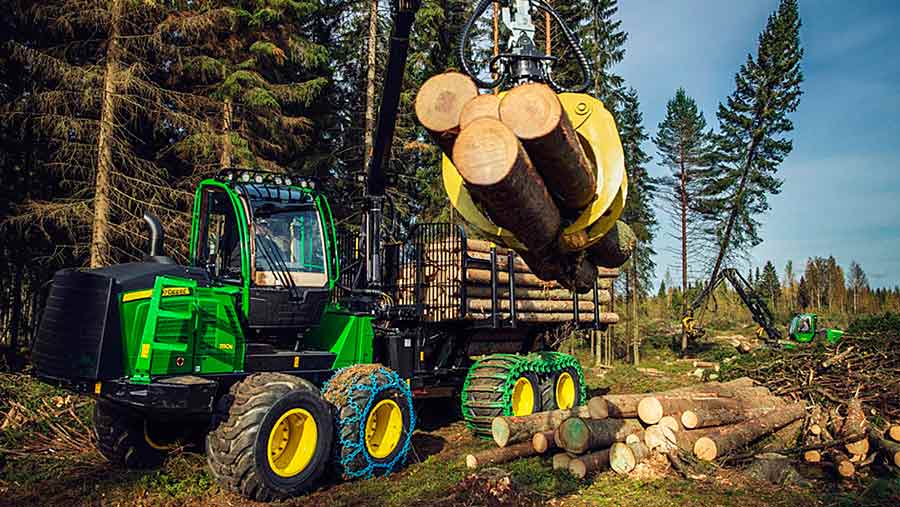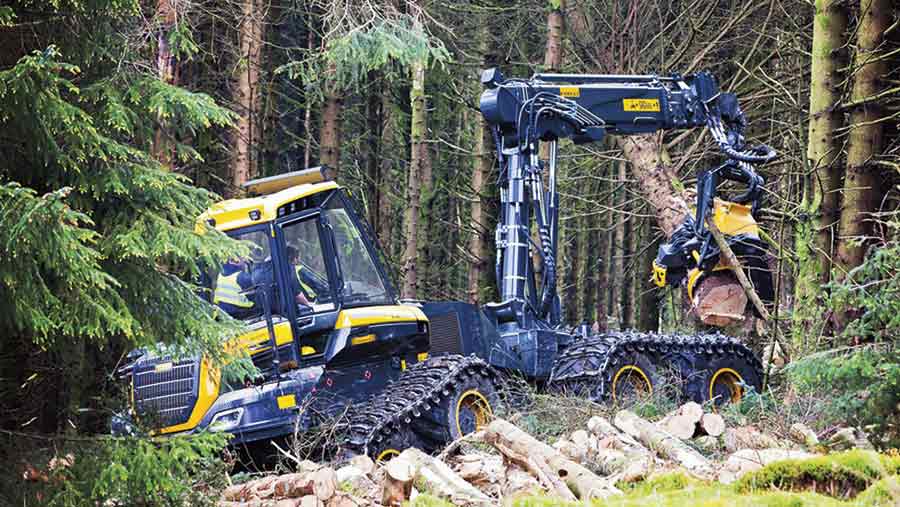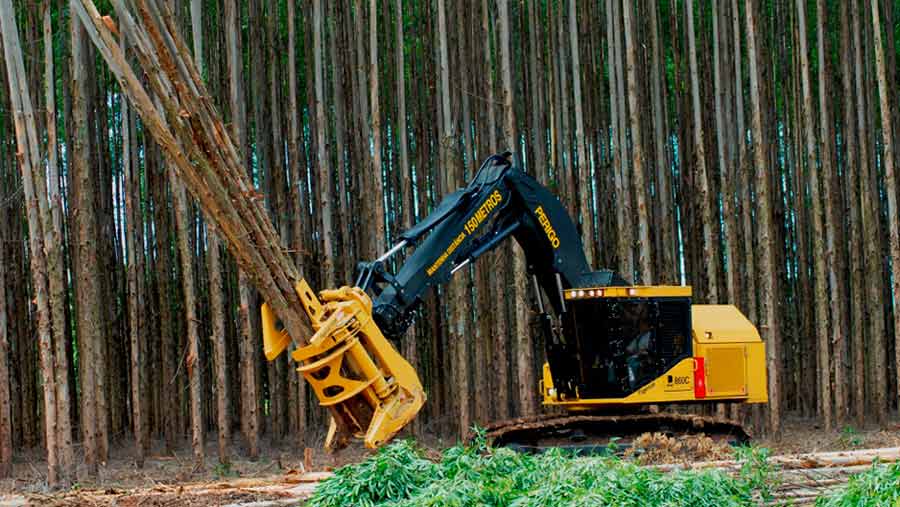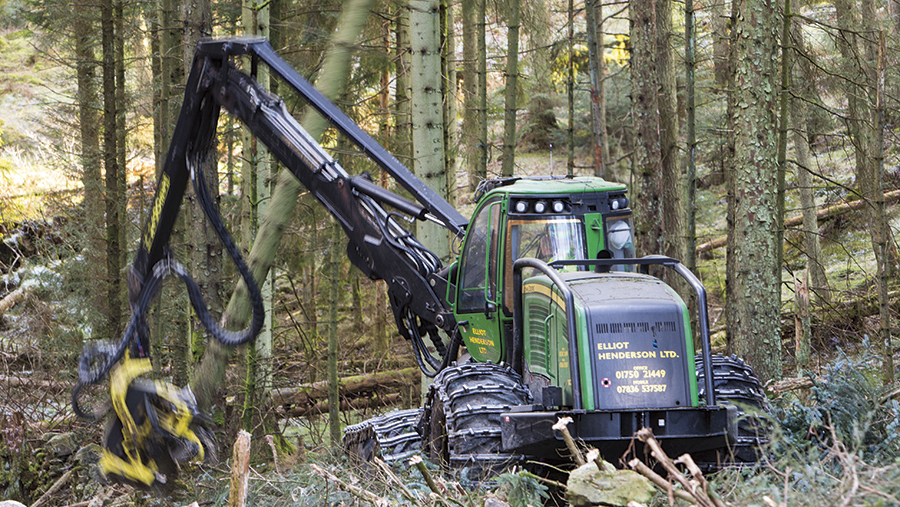Unusual harvesters: The kit used to fell and haul timber
The UK produces about 11m tonnes of softwood and half a million tonnes of hardwood every year in a market estimated to be worth about £2bn.
Some serious kit is needed for felling and hauling – the process has come a long way from 19th-century methods, when logging was carried out with the brute strength of humans and animals.
Large gang saws – typically requiring two men to operate – did the felling, while horses and donkeys provided the muscle to pull sleighs and wagons.
Greased-up skids or long poles were laid crossways along trails to help move cut logs, which were hauled to rivers and often shifted by boat to nearby timber mills.
See also: The machine that harvests macadamia nuts
In the 1880s, steam-powered winches came into use. Hoists and steel cables sped up the business of hauling the logs from the forest to the trail, while traction engines were used for transport and driving bench saws.
Demand for British-built equipment was high and several manufacturers exported their machines all over the world.
Eventually, tractors replaced traction engines and County and Roadless started to specialise in machines with grabs and winches.
American and Scandinavian companies developed articulated skidders (used to drag large logs from stump to road) and forwarders (also to lug logs from stump to road, but clear of the ground).
These appeared in the 1960s, at the same time as articulated technology was being used in agricultural tractors by the likes of Steiger and Wagner.
Modern-day machines
Today, the biggest names in forestry equipment are John Deere, Caterpillar and Komatsu, which acquired Valmet in 2004.
There is also a host of more specialised companies, including Ponsse from Finland, Rottne, TigerCat and TimberPro.
German company NAF provides axles and bogie systems to forestry machines, while Welte produces smaller forwarders.
Valtra no longer produces purpose-built forwarders, but provides numerous options that favour forestry work, including front pumps and auxiliary hydraulics, reinforced subframes, reverse-drive machines and a special forestry cab.
Harvesters
Ponsse’s Bear is the largest harvester in its range and comes with a 350hp Mercedes engine and a harvester head that alone weighs 1.2t. Eight-wheel drive and meaty 750/55 R26.5 tyres are also part of the package.
The machine first cuts the tree down before feeding it through the harvester head to strip off the smaller branches. Trees can be cut to a predetermined length, with a maximum cut diameter of 74cm and an output of up to 5m/sec. The crane will reach up to 10m.
Harvesting and felling heads play a role similar to that of a combine header. They are the first point of contact, and an effective head goes a long way to determining the output of the machine.
Komatsu provides a choice of 15 different heads, while companies such as Waratah specialise solely in harvesting heads, which are built in New Zealand and Finland.
Feller bunchers
A feller buncher is used to grab several smaller trees or saplings to cut them together. Such machines can either be wheeled with a fixed head that drives up to the trees, or have an articulating arm.
For very steep terrain, crawler harvesters and bunchers are used with self-levelling cabs, similar to the mechanism employed on hillside combines and pea harvesters.
The Canadian-made TigerCat, which is imported to Scotland by Treetop Forestry, has put several of these machines into the UK.
Forwarders
Once the trees are cut, they must be hauled out of the forest, which is the job of the forwarder. Most forwarders have a carrying capacity of 10-20t.
Ponsse’s biggest seller in the UK is the Buffalo, which has an 18t capacity, a steering system with 44 deg of articulation and is powered by a 275hp Mercedes engine.
Both forwarders and harvesters are highly configurable, with options including type of grapple, harvesting head, chains or tracks, and six or eight axles.
Soil compaction and damage is as much a concern in forestry as in agriculture. Ponsse’s Gazelle weighs 10t, but can be fitted with a fifth axle so that the machine applies ultra-low ground pressure.
Skidders
Skidders are used for hauling out bigger trees and come with either a grapple or a winch, or sometimes both. They require fast cycle times, good manoeuvrability, frugal fuel stats and decent operator comfort.
Most are twin-axled, but TigerCat’s top-of-the-range 635E has a 5.2m wheelbase and six-wheel drive, and is powered by a 266hp oil burner. Dual and flotation tyres are an option.
Logging intelligence
GPS systems are being used in logging, just as they are in agriculture.
They help locate the cutting area and record where the logs are left, so the hauling trucks can be guided to the right spot. Otherwise, truckers could spend hours hunting through the forest to find a pile.
Harvesting heads multiply thickness of trunk passing through with speed to calculate the quantity of material harvested per hour. John Deere also offers its Intelligent Boom Control system, which allows the operator to control the tip of the boom (rather than having to control each boom joint independently).
Co-ordinating the different machines to achieve efficient thinning or clearing of a plot requires considerable planning. Ponsse has developed a computer simulation game to help train forwarder drivers, while John Deere offers TimberOffice – a software suite for managing all the equipment.
Prices for all this sophistication equate to those of combines or beet harvesters, with the machines mentioned costing anywhere from £150,000 up to £300,000 or even more.

